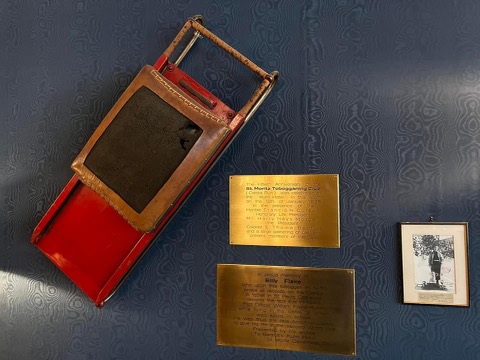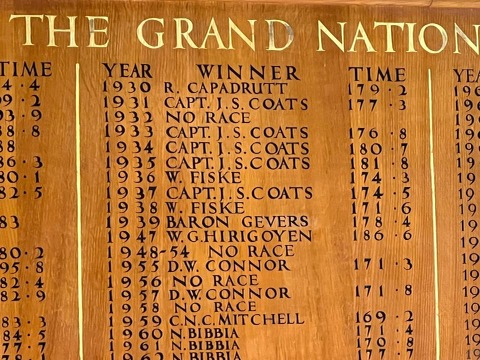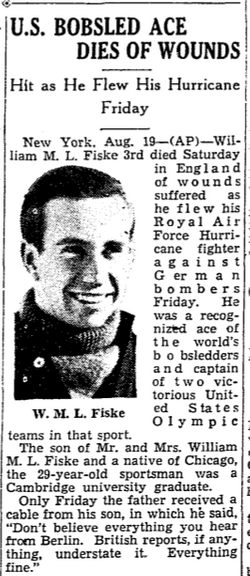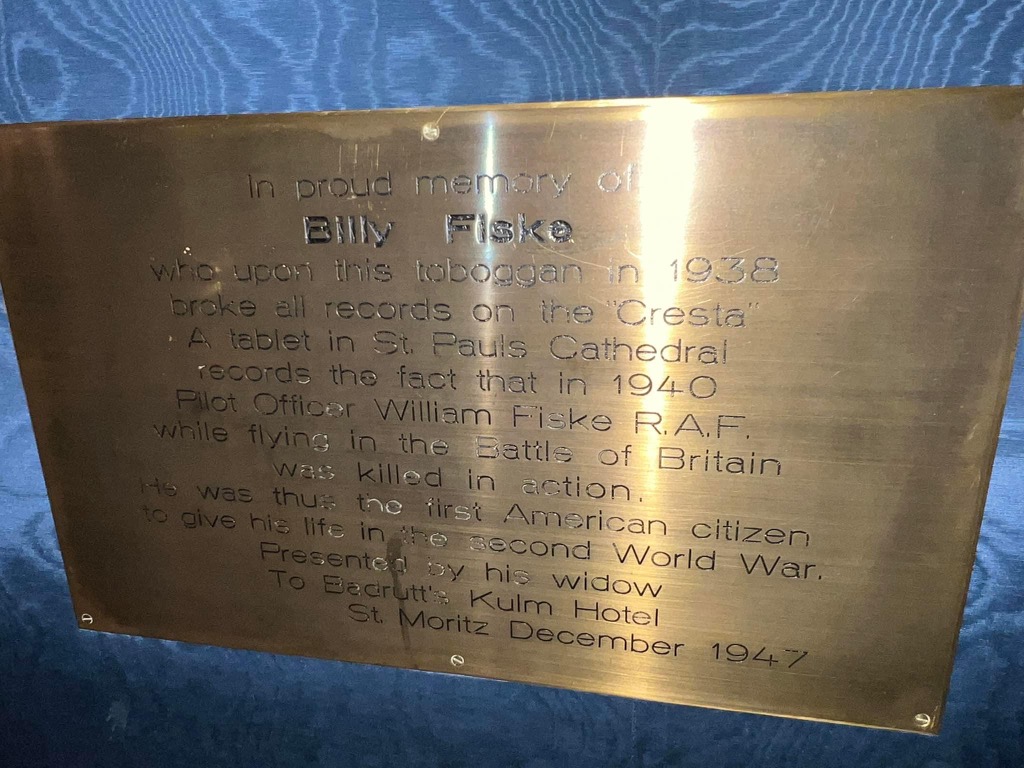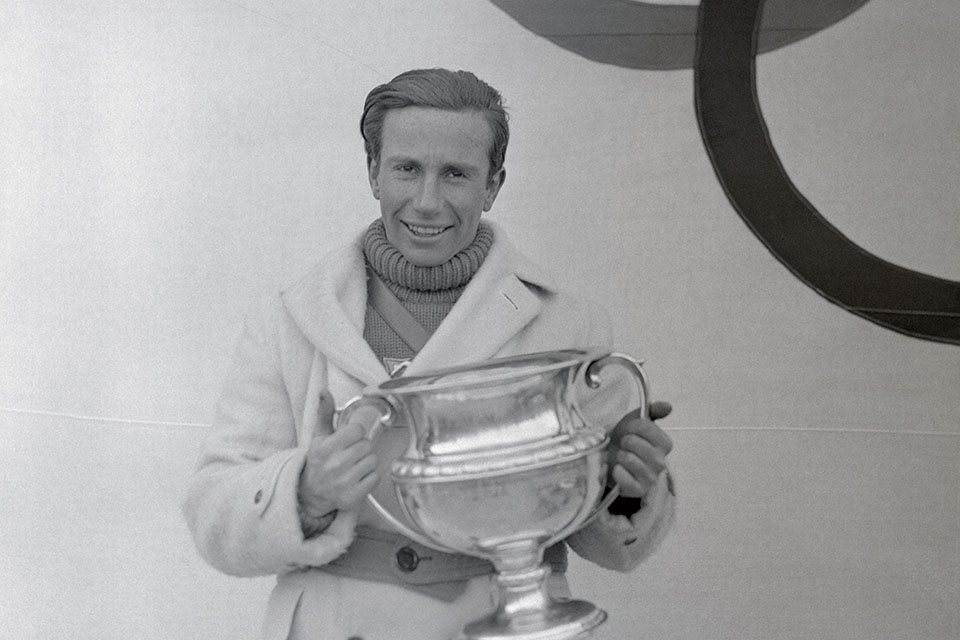Billy Fiske Memorial Wall
Details:
In a bar in the grand hotel.
A few items on a wall to include a individual toboggan, picture and an inscribed brass plaque.
A bit about Billy Fiske from Military History Matters Online (Feb 27, 2020):
War Athletes: Billy Fiske
For the uninitiated, the sport of bobsleigh (or bobsled) involves teams of two or four athletes crammed inside a flimsy sled, hurtling down a labyrinthine, banked course made of ice. The action is fast, thrilling, and dangerous.
Not surprisingly, the high-speed event attracts a particular breed of devil-may-care competitors hellbent on pushing the envelope — men such as Billy Fiske.
The Chicago-born ‘slider’ became the youngest Olympic gold medallist ever as a 16-year-old at the 1928 Winter Olympics in St Moritz. Four years later, while serving as his country’s flag bearer, he piloted Team USA to another victory in Lake Placid.
Additionally, he raced fast cars and enjoyed a long reign as the king of Switzerland’s infamous Cresta Run.
But among all his adrenaline-fuelled exploits, Fiske is best known for his courage and sacrifice as the first American airman killed in combat during WWII.
William Meade Lindsley Fiske III was born on 4 June 1911 to a wealthy family claiming roots dating back to early Colonial America. The blue-blooded youth attended private schools in Europe, where he developed an affinity for alpine sports.
Although bobsleighing earned him Olympic glory, his dominance in the head-first skeleton made him a sledding god.
The hair-raising event originated in the late 19th century, created by the founders of the St Moritz Tobogganing Club, and featured a natural ice-covered track called the Cresta Run. There, in the shadow of the Alps, Fiske honed his racing skills, winning numerous prestigious titles and routinely setting track records.
The popular athlete added to his legend with jumps from the chandelier at Badrutt’s Palace Hotel, an elite winter resort where he mixed with the upper echelon of British society — connections that would have a major impact on his future.
Olympic Boycott:
Fiske moved to England and attended Trinity Hall, Cambridge, where he studied economics and history. He continued his obsession with speed, torching country roads in a supercharged racing-green open Bentley (‘Blower Bentley’) and held the unofficial Cambridge to London record.
At the still prime age of 24, he was expected to win another Olympic gold medal — this time at the 1936 games in Garmisch Partenkirchen, Germany — but chose not to compete.
The double gold medallist never publicly gave his reasons, but a Jewish friend and fellow Olympian, Irving Jaffee, insisted Fiske objected to the anti-Semitism of Hitler’s Nazi regime.
Nonetheless, Fiske remained busy with a full slate of pursuits, claiming yet more sporting titles and developing a world-class ski resort in Aspen, Colorado.
In 1938, the same year he learned to fly, the Anglophile took time out from his whirlwind schedule to marry Rose Bingham, the former Countess of Warwick.
Meanwhile, Fiske could not ignore Germany’s war drums growing louder; but he faced an imposing high hurdle if he decided to fight. America’s neutrality strictly forbade its citizens from ‘entrance into or service in military or naval forces’.
Undaunted, he circumvented the ban by using forged Canadian papers and his well-heeled contacts to gain acceptance into the Royal Air Force Volunteer Reserve (RAFVR) shortly after the outbreak of war in September 1939.
The athlete-turned-fighter jock undertook flying training at No.10 Elementary Flying Training School in Yatesbury, Wiltshire. After logging enough hours in a Gloster Gladiator biplane, he then advanced to No.2 FTS in Brize Norton, Oxfordshire.
Fiske expressed his motivation to enlist in a letter to his sister, Beaulah (‘Peggy’), stating that the English had:
. . . been damn good to me in good times so naturally I feel I ought to try and help out if I can. There are absolutely no heroics in my motives, I’m probably twice as scared as the next man, but if anything happens to me, I at least feel I have done the right thing in spite of the worry to my family – which I certainly couldn’t feel if I was to sit in New York making dough.
Millionaire’s Squadron
On 10 July 1940, the Luftwaffe commenced softening up England ahead of Hitler’s planned invasion. The Battle of Britain had begun.
Fiske joined No.601 (County of London) Squadron, Auxiliary Air Force (AAF), based at RAF Tangmere in Sussex. The so-called ‘Millionaires’ Squadron’ (known amongst themselves as ‘The Legion’) comprised aristocrats and adventurers with a well-earned reputation for flamboyance and little regard for military discipline.
They socialised at the exclusive White’s Club in London, and most of the squadron owned their private aircraft , including British ski-jump champion, Willie Rhodes-Moorhouse.
Fiske easily adjusted to the controls of his Hawker Hurricane Mk I. The Olympian often compared the handling of the fighter and its supercharged Rolls-Royce RM 1S Merlin engine to that of his treasured Bentley.
His adroit hand-eye coordination — not to mention the bone-rattling G-forces he experienced sliding on ice — provided invaluable hardening for his latest endeavour. Flight Lieutenant Sir Archibald Hope, 17th Baronet, later expressed his awe of the talented American:
Unquestionably, Billy Fiske was the best pilot I’ve ever known. It was unbelievable how good he was. He picked it up so fast it wasn’t true. He’d fl own a bit before, but he was a natural fighter pilot. He was also terribly nice and extraordinarily modest and fitted into the squadron very well.
Pilot Officer Fiske flew his first operational sortie on the morning of 20 July. Over the next 27 days, he engaged in 42 operations that included the vital protection of Allied convoys in the English Channel.
An entry from his logbook reveals the plucky aviator’s candid observations: ‘Intercepted 200+ Me 110 & 109. Saw 4(?) probables 3 badly damaged. Sqdn lost 4. Terrific fight. Terrified but fun. Had to lead sqdn in. Willie’s engine failed!’
Fiske may have tallied as many as six kills total, but either modesty or lack of confirmation prevented him from being credited as an ace.
Champion’s ego:
The Luftwaffe continued stepping up its bombing raids with targeted assaults on RAF airbases, including Tangmere.
On 16 August, RAF Fighter Command detected a large formation of Ju 87s crossing the English Channel just east of the Isle of Wight, heading straight for the Sussex coastline.
The dive bombers would inflict substantial damage to the aerodrome and surrounding areas as the 601 scrambled to intercept them.
Fiske, flying in his second operation of the day, accompanied his squadron in a series of fierce dogfights that resulted in the downing of eight Junkers.
But as the American chased a Stuka out to sea near Bognor Regis, a German tail-gunner punctured the Hurricane’s reserve fuel tank, causing a fire to erupt in the cockpit.
Driven by stubbornness and a champion’s ego, he refused to bail out and managed to glide the warbird back home with a dead-stick landing.
Fiske suffered severe burns to his hands and ankles and had to be carefully extracted from the plane by the ground crew. Shortly after, his fuel tank exploded.
He received treatment at nearby Royal West Sussex Hospital in Chichester but died the next day from surgical shock.
A funeral service took place on 20 August 1940 at St Mary and St Blaise Church in the town of Boxgrove. The inscription on his gravestone simply reads: ‘He died for England’.
Several memorials and tributes soon followed. British military officials unveiled a large tablet in the crypt of St Paul’s Cathedral in London, and the United States Bobsled and Skeleton Federation later inaugurated the Billy Fiske Memorial Trophy, an award given annually to the US four-man national championship team.
See this website ISOB Fiske and William “BILLY” Fiske III – Battle of Britain Plaque in St. Paul Cathedral and several more for more on Fiske.
Monument Text:
In Memory of
Billy Fiske
Who upon this toboggan in 1938
Who broke all records on the “Cresta”
A tablet in St. Paul’s Cathedral
records the fact that in 1940
Pilot Officer William Fiske R.A.F.
while flying in the Battle of Britain
was killed in action.
And was thus the first American citizen
to give his life in the Second World War.
Presented by his widow
to Badrutt’s Kulm Hotel.
St, Moritz December 1947
Commemorates:
People:
William Meade Lindsley “Billy” Fiske
Units:
601 Squadron, RAF
Royal Air Force (RAF)
Royal Air Force Volunteer Reserve
Wars:
WWII
Battles:
Battle of Britain
Other images :

